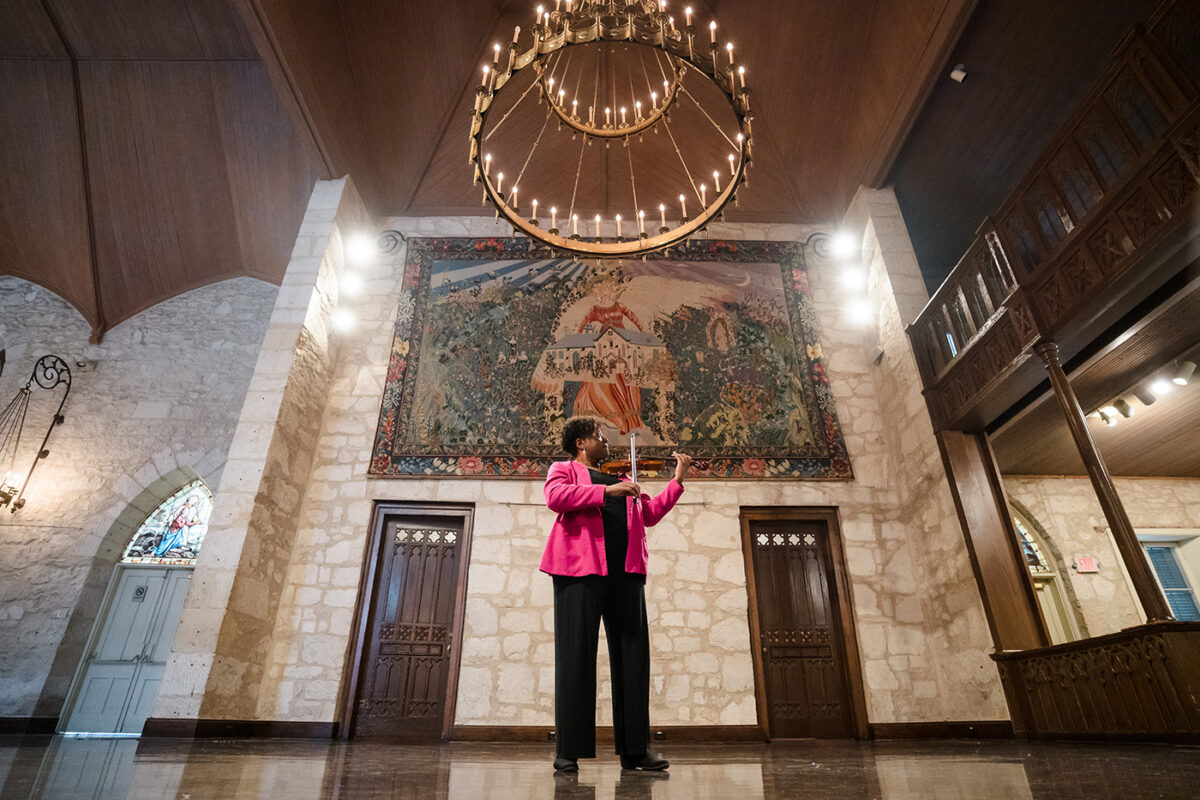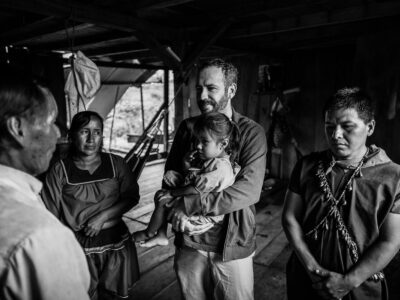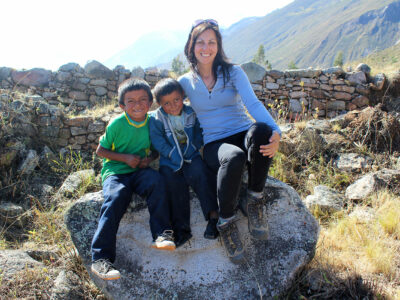For Nicole Cherry, assistant professor of violin and string area coordinator at the UTSA School of Music, the violin is more than an instrument that she learned to play when she was 12 years old. The instrument has taken her across the globe to perform and collaborate with some of the greatest musicians in the world. But most importantly, it has enabled her to break down historical barriers and engage diverse communities in the joys of the music.
Sombrilla Magazine sat down with Dr. Cherry to learn more about her journey.
How did you get started in music? What sparked your interest?
My first memories of music are in my home. My mom and dad were avid fans of all music and very intentional about exposing my brother and me to the breadth of arts and culture. My father was an amateur pianist and after dinner, as a young child, I would often find myself sitting at my father’s feet as he played piano. He would play anything from Thelonious Monk to Franz Schubert as well as some of his own improvisations. It was natural for me to play music, and so I started learning piano at age 6 and then violin at age 11 in public school. Soon after that, my older brother, who is a bassist, would take me to improvisation sessions, and I think this was the beginning of my curiosity surrounding the possibilities of music.
You have an extensive professional career that allows you to travel the world and meet so many people. Did you ever think you’d have that opportunity?
In just the last three years, I have performed on four different continents, and when I think of that, I am grateful but in disbelief. What I have learned is that when someone believes in you, it allows you to believe in yourself.
Growing up, I was a member of the DC Youth Orchestra Program, and during my time there, we toured the world. We performed before dignitaries, premiered symphonies, met some of the greatest artists of all time. We would perform for the White House on a Friday then have our regular rehearsal on Saturday, oblivious to the impact we were having on our own lives as well as others.
Little did I know then that I was sitting within a student orchestra made up of many of today’s award-winning international performers, orchestral players and arts administrators. That experience gave me a place to feel represented, to be part of a nurturing community, where I was not just a violin player, but part of a group that was needed to make it whole.
The DC Youth Orchestra promoted inclusivity, growth and the opportunity to excel. It was there that I knew I wanted to expand this model as a significant part of my life. And now I develop art projects that allow me to tour the globe to speak on issues that I believe in, curate programs that mirror the people we live with and perform with some of the most esteemed musicians in the field. I am always grateful for the opportunities I have now, but the belief that I could do this was fostered by the mentors I was so fortunate to have in my youth.

What did the representation look like in the classical music community when you were growing up?
When my classmates and I at the DC Youth Orchestra worked with the American composer Talib Rasul Hakim, we were able to make music in real-time with this living composer. We could experience the music literally evolving and transforming just because we were there together, which was life-changing.
At age 16, I gained some courage, mostly out of my own curiosity, and took it upon myself to connect with as many artists as I could. I reached out to a several composers — everyone from the great Quincy Jones to Jonathan Wolff, the composer of the “Seinfeld” TV show music.
I learned quickly that representation is an important part of mentorship. As Toni Morrison put it, “…if you have some power, then your job is to empower somebody else.”
I remember some feedback I received: Gunther Schuller let me sit in on the dress rehearsal just because I showed up early and asked. George Walker let me interview him over the phone after looking up his number. Jeffery Mumford encouraged me to play and teach new music. Tania Leon had no problem letting me arrange her woodwind piece for strings. Victoria Bond told me sometimes you must be the teacher and be your own teacher. When I asked David Diamond, in passing, “What is the key to playing contemporary music?” he responded, “Play the new like it’s old and the old like it’s new.”
One significant meeting for me was with the American composer Noel DaCosta. He invited me over for lunch to talk music and mentioned that his role model for composition was Harlem Renaissance poet Countee Cullen. From this, I learned to stay open to anything that might inspire me. Dr. Da Costa gave me scores, passed me phone numbers, and ever so grateful as a college student, he fed me food! As a violinist himself he helped me understand the legacy of the Black American fiddler, and I began to realize that my artistic purpose stemmed from several interests that seemed to intersect.
How are you applying those realizations here at UTSA?
I think that’s what is beautiful about UTSA. Learning about musicians and composers from many different races, ethnicities and cultures is an intentional part of the educational curriculum.
Great music programs can be built by understanding the context of the people and places that surround us. This past year at UTSA, I began a String Band in which we explore music from all over the world from a historical, cultural and performative point of view. Recently, I introduced a new piece, Mi Negra by Jesús Florido, to the group. Many of the students, though they had heard these sounds before, could not easily translate it from the score. After much conversation with and without instruments and many student-led rehearsals, they were able to perform it beautifully. This is what I call a creolized music education — one that evolves from different components of many languages across the diaspora.
Tell me about your scholarly work and how it relates to what you’re doing outside the university as a performer.
My scholarly work is built around a project I started in 2016, FORGEwithGEORGE. The project is named after 19th century African-European violin virtuoso George Augustus Polgreen Bridgetower. My goal is to commission an entirely new body of repertory for violin each year until the 200th Anniversary of the Slavery Abolitionist Act in England, where Bridgetower lived.
Currently, I have commissioned over two dozen compositions and premiered many of them with collaborators worldwide. The project is a combination of performances, lectures and recitals where I’m hoping to restore the legacy of great artists of color that have been dismissed from our history books.
Tell me about your work with the Marian Anderson String Quartet and what led you to join them.
I am proud that I was a fan of the group for more than a decade before I became a member, and I have now been a member for 22 years! The Marian Anderson String Quartet encompasses all that I believe in as an artist — building community and sharing art inclusively to all communities. The Marian Anderson String Quartet has performed at presidential inaugurations, the Library of Congress and more. They made history in 1991 when they won the International Cleveland Quartet Competition — the first African American ensemble to win a classical music competition.
And yet, no stage is too small — and no stage is small. One day, we could be playing in the Lincoln Center in New York and the next day playing at the YMCA or a prison. We come to them and share our experience of loving classical music. We’ll play Mozart and other classical composers alongside many composers who are people of color.
I am motivated by that mission and what we do to honor the legacy of our namesake, Marian Anderson.
Why is it important to you to visit communities that don’t have access to classical music?
A while back, I discovered a story about George Bridgetower’s father John Frederick Augustus, who in 1790 took young George at the age of 11 from Paris to Windsor Palace to share the musical brilliance of his son with King George III. It was Charlotte Papendiek, the lady in waiting to Queen Charlotte, who answered and let him in, although according to her memoir, she called him “that annoying Black Bridgetower.”
Many visits later, and many royal gathering performances later, the Prince of Wales (soon to be King George IV) became the patron for young George Bridgetower for the next decade or so. If it weren’t for the efforts of his father John Frederick and the access permitted by Charlotte Papendiek, we would not know anything of the gifts of George Bridgetower today. When I learned about this interaction and George Bridgetower’s contribution to music, it was life-shifting for me.
This represents an act of decolonizing your community. By going into communities and providing that access, we can reshape our communities and bring forward those who have been excluded, invisible or silenced.
I am also drawing on the philosophy of another George, composer George Lewis from Columbia University. He draws on the model of a creolization as a way toward decolonizing music. He chose this metaphor because it specifically references race and a multi-national perspective. He says that a creolized contemporary music culture would be race-aware, not race-deaf. It would create a kind of mosaic — one that recognizes historical, geographical and cultural cross-connections with a complexity that has a far greater creative depth.
I believe that this combination is a foundation for a breathing, pulsing community — one that will continue to thrive.


